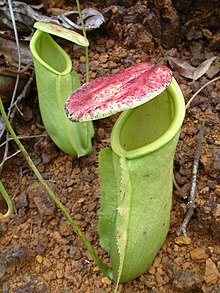Nepenthes neoguineensis
| Nepenthes neoguineensis | |
|---|---|
 |
|
| Lower pitchers of N. neoguineensis from Western New Guinea |
|
| Scientific classification | |
| Kingdom: | Plantae |
| (unranked): | Angiosperms |
| (unranked): | Eudicots |
| (unranked): | Core eudicots |
| Order: | Caryophyllales |
| Family: | Nepenthaceae |
| Genus: | Nepenthes |
| Species: | N. neoguineensis |
| Binomial name | |
|
Nepenthes neoguineensis Macfarl. (1911) |
|
| Synonyms | |
|
|
Nepenthes neoguineensis /nᵻˈpɛnθiːz ˌniːoʊˌɡɪniˈɛnsɪs/ is a tropical pitcher plant native to the island of New Guinea, after which it is named.
Nepenthes neoguineensis was first collected in 1828 by Alexander Zipelius near Triton Bay, New Guinea. Two further collections were made by Gerard Martinus Versteeg on June 19 and September 25, 1907.N. neoguineensis was again collected on May 10, 1910, by Knud Gjellerup.
The first name applied to this species was Nepenthes leptoptera by Hermann Zippel in 1900. However, this name is not valid as it only appeared on the label of a herbarium specimen (HLB.908.154-597) deposited at the National Herbarium of the Netherlands in Leiden. The specimen was collected from New Guinea.
Nepenthes neoguineensis was described by John Muirhead Macfarlane in 1911 based on the specimen Versteeg 1746, which consists of female plant material.
In 1916, Henry Nicholas Ridley described what he believed represented a male plant of N. neoguineensis. However, in his seminal monograph "The Nepenthaceae of the Netherlands Indies", B. H. Danser showed that it belonged to a closely related but distinct species, which he named N. papuana.
...
Wikipedia

